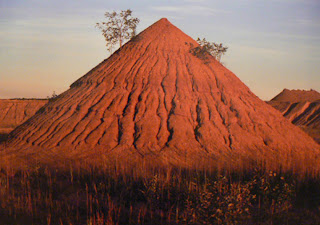Last week I was lucky enough to be involved in a panel discussion and exhibition at the Cultural Foundation in Abu Dhabi. Organised by the Abu Dhabi Authority of Culture and Heritage and the Goethe-Institut Gulf Region, the exhibition runs until November 1st.
The panel was chaired by Konstantin Schreiber of Deutsche Welle TV and featured artists who work in some way with environmental issues. The main artist, German photographer Petra Petrick exhibited a series of photographs called ‘German Desert’. The images are desolate, barren and beautiful just like real deserts but actually taken at the abandoned sites of former open cast coalmines in Germany.
Khorfakkan artist Abdullah al Saadi exhibited a wall length panoramic scroll of the Khorfakkan coastline created while in a boat looking back at the coast. His work monitors the change in the landscape as new buildings, especially hotels, arise and aspects of the natural landscape are removed. In some cases this includes parts of mountains.
Muna al Ali arranges potted plants in various stages of growth to comment on the inevitable cycles of life and decay to which we are all subject. The first time I saw this installation called ‘Dialogue with Nature’ was in the Creek Art fair last March. At that time all the plants were very healthy looking but now the dialogue is communicating something much less optimistic.
My work consisted of three ‘Towers of Trash’ which also featured in the Creek Art fair last year, and two ‘Artificial Landscapes’. These are painted on recycled board and depict landscapes but in a totally artificial way using unnatural colours, perspectives and materials.
Mohammed Kazem had several photographs in the exhibition illustrating the rapid urbanisation of the landscape around Dubai and more abstracted work using details of the urban emnvironment.
In the panel discussion itself the artists talked about how their work relates to changes in the environment around them and reflects and interprets these changes. Petra Petrick’s haunting photographs are testament to industrially devastated landscapes and Abdullah al Saadi is chronicling contemporary landscape loss. My work tries to address the fact that there are long-term consequences of having one of the highest amounts of waste per capita and Muna al Ali reminds us of the inevitable!
While the undeniable benefits of development are visible, the negatives, particularly in relation to the environment, tend to be invisible in the short term so are easy to ignore. However, none of this work is meant as an unambiguous criticism of development or Dubai but is more a mechanism to raise questions about issues of land use, environmental sustainability and even public health. Ultimately the environment is the great leveller. We are all equally dependent on it for our survival not only as individuals but also as a species. From a creative point of view it has been the inspiration for some of the world’s greatest art, greatest music and greatest poetry. If it changes we change with it and as Muna’s work suggests, a dialogue with nature is probably easier while it still seems relatively healthy!







No comments:
Post a Comment